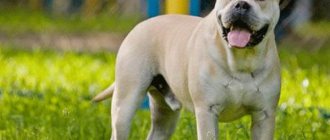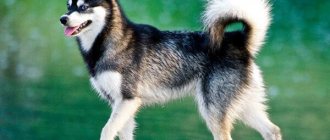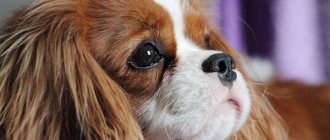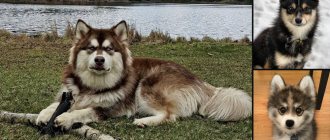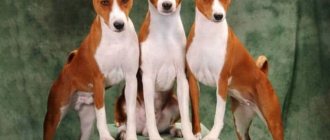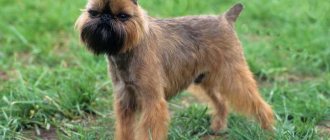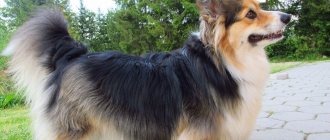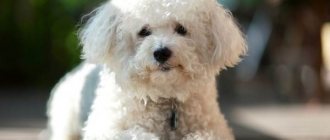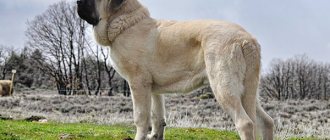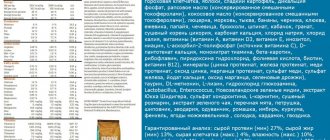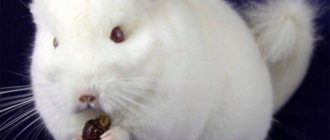Husky is a breed of dog whose attractive appearance and good-natured character have won the hearts of many dog breeders around the world.
Bred for hard physical work and to this day retaining good working qualities and endurance, representatives of this breed today are most often simply faithful companions.
In this article you will get acquainted with a comprehensive description of the Husky breed, which will be useful and interesting for both beginners and experienced dog breeders.
History of appearance
Husky is one of the 14 oldest breeds, bred in northeastern Siberia. The exact time of origin of these dogs is unknown, but scientists suggest that their age is 3 thousand years or more.
Huskies owe their appearance to the Chukchi, who lived on the Arctic coast for many centuries and needed hardy dogs suitable for driving long distances and transporting goods.
In addition, due to the lack of provisions, these dogs had to have a minimal need for food, despite significant physical exertion.
Smart, good-natured, fast and resilient, huskies met all the requirements. These dogs were kept both on the street and in yurts for the purpose of warming small children. The long-term isolation of the peoples of northeastern Siberia determined the long-term preservation of the purity of the breed.
NOTE!
Over time, Americans became interested in the breed, and in 1930 Huskies were recognized by the American Kennel Club, and in 1934 an official standard was adopted. The Canadian Kennel Club recognized the breed in 1939, and individual representatives of the breed were brought to Russia in 1995.
Interesting facts about the breed:
- Husky is a distorted version of the slang "Eski", which the Americans used to call Eskimos.
- Translated from English, “husky” stands for “husky”, since representatives of this breed do not bark, but make hoarse sounds.
- A husky team can travel about 250 km, reaching a speed of 25-35 km/h.
- In 1925, a husky named Balto was the leader of the team that brought diphtheria serum to Alaska, this story is shown in the Disney cartoon.
How much does a Siberian Husky cost?
There are several factors that influence the cost of husky puppies.
This includes the presence of a pedigree, the individual qualities of the baby (appearance, physical fitness, gender), and the status of the parents. It is clear that the cubs of champion dogs - in the case of huskies, not only for exhibitions, but also for sports competitions - will cost much more than the babies of ordinary parents. If you just want to have a friend at home and don’t bother with a show career, your choice is a pet-class puppy. It will cost 20-25 thousand rubles. Most likely, it will be sold without a pedigree, but will that stop you?
Breed-class dogs already cost from 30 thousand rubles. They have all the necessary documents and are quite suitable for breeding work. Some minor deviations from the breed standard are possible.
The most expensive are show class puppies. Such animals fully comply with official standards, have no flaws and are born husky champions. The price for a dog of this class can be more than 60,000 rubles. Buying a baby without the advice and help of an experienced breed expert will be very problematic.
When planning to buy a Siberian Husky, do not chase the low price. On the contrary, such a proposal should alert you. Most likely, ordinary deception or dishonesty is taking place. A husky puppy, taking into account the costs the breeder incurs when breeding this breed, simply cannot be cheap.
Description of the breed
These are medium-sized dogs belonging to the group of working sled dogs. They have a harmoniously built muscular body. They move with an even, easy, effortless gait.
Characteristics of the breed standard:
- the head is medium in size, proportional to the body, the skull is slightly rounded, tapering towards the eyes;
- the muzzle is not too long, the bridge of the nose is straight, the transition from the muzzle to the forehead is clearly defined;
- the eyes are slightly slanted, almond-shaped, the iris can be blue, dark blue, gray or brown, heterochromia is often noted;
- ears are medium size, triangular, set high, tips slightly rounded;
- the nose can be black, brown or gray, depending on the color of the coat;
- scissor bite;
- the chest is wide and deep;
- the back is straight, level;
- The limbs are straight, the thighs are well-muscled, the paws are oval and compact.
The husky's coat is thick and dense, allowing dogs to withstand frosts down to -50-60 °C without problems.
Appearance of the Husky breed
The Siberian Husky is a sled dog that was bred to work. Fluffy dogs in the frosty north had to pull a team with a person and luggage over long distances. As time passed, the American standard changed its reference point from working to exhibition. The Husky was considered a show dog. People are often attracted by the appearance of these beautiful, majestic dogs. And this is not surprising - with their wolf-like features, thick, soft fur and blue or multi-colored eyes, huskies are sure to attract the attention of any passerby.
Size and weight
The animals are of medium size. A male at the withers reaches 54–60 cm and weighs 21–28 kg, a female – 51–56, weighing 16–23 kg. If a dog's height exceeds the acceptable guidelines, it may be disqualified.
A husky's weight and height are directly proportional. If you look at the dog from the side, then the length of its body should exceed the height at the withers.
Husky color and coat type
Color ranges from pure white to pure black.
The official colors of the Siberian Husky are recognized in Russia:
- grey-white;
- black and white;
- brown-white;
- white.
A characteristic feature of the paroda is the white markings on the head, similar to a mask.
The coat is medium length, with a soft and dense undercoat. However, even when creating a drooping effect, it is possible to see the lines of the body. The outer coats should be smooth and straight, not rough and erect. Shaggy, coarse coat can be considered a disadvantage of the breed.
There are no hypoallergenic huskies among the representatives, so petting dogs is not recommended for children with allergies.
Types of Huskies and how to distinguish them
Husky is the general name for sled dogs in various regions, the difference between which lies in the degree of color saturation, the outline and color of the eyes, and the height of the dogs. The emergence of species is associated with places of origin.
Kinds:
- Alaskan. It owes its origin to the border collie, malamute, and shepherd dog. Human friends feel great in severe frost, despite their short fur. By nature they are more gentle and devoted, ideal friends for small children.
- Sakhalin Husky or Sakhalin Laika. Compared to other species, it has long hair. By nature - calm, devoted to people. It has high endurance and strength. Since the dog reaches 70 cm at the withers, it is not bred at home.
- Klee-kai. In 1970, a variety of mini-husky was bred in the United States. Thanks to its height of 33 cm and weight of 7 kg, it is ideal for keeping in a small apartment. Life expectancy is 16 years.
How to distinguish a husky from a malamute?
The Alaskan Malamute and Siberian Husky are characterized by their riding qualities. The first is characterized by strength, the second by speed. The Malamute's powerful body allows it to carry large loads. The dog is calm, unhurried, and rarely speaks. The coat color can be brown, black or gray. The fur is erect and rough. Unlike a husky with blue eyes, the Malamute's eyes are brown, with black eyeliner visible. Weight and height exceed the characteristics of a husky.
Akita, Samoyed, Malamute are similar in body shape, coat color and purpose to Siberian Huskies, but are considered independent breeds.
Character traits
These are affectionate and good-natured dogs that are not prone to anger. They are friendly towards everyone, but if they sense the malevolent intentions of strangers, they can become aggressive.
Huskies do not have a guarding instinct, but with proper training they can be trained to guard the house. However, the maximum that can be achieved from representatives of this breed is to teach them to warn about the visit of strangers; they will not protect property.
These are pack dogs that need constant contact with other animals and people; they cannot be alone. Huskies love people, but do not become attached to one owner. These dogs do not tolerate neglect, since they have always existed on an equal footing with people.
Despite all their goodwill and agreeableness, representatives of this breed have a complex character. They are willful, stubborn, accustomed to making their own decisions and striving for dominance, so it is important from the first days of the puppy in the house to show him that he is not the leader.
During training and education, it is necessary to show patience and perseverance, not allowing the dog to relax and shirk the command.
There are some differences in the character of males and females.
So, the boy’s character is as open and straightforward as possible. Males are not characterized by cunning or any tricks - they openly demonstrate the desire to dominate, are very freedom-loving, independent and can behave aggressively with strangers, defending their leadership and superiority.
Bitches are affectionate and more owner-oriented. They have a soft and calm disposition, they are more obedient and flexible. However, they are very cunning and are able to achieve what they want using a lot of tricks.
Expert opinion
Kozhevin Semyon Kirillovich
Expert dog handler.
When getting a Husky, you should understand that the character of the representatives of this breed largely depends on genetics. Therefore, before buying a puppy, it is important not only to examine it to ensure it meets the breed standard, but also to get to know its parents and find out in as much detail as possible what kind of character they have. What is inherent in all dogs of this breed without exception is a dominant type of behavior, stubbornness and willfulness. They will never obey; you can achieve obedience from them only by showing leadership qualities and winning their trust and favor. These dogs can only be equal companions and partners.
Raising and training a husky
Huskies are very smart, but headstrong animals. Inexperienced dog breeders who have no experience in training should not get such a pet. The breed is also not suitable for weak-willed people who will not be able to show persistence and firmness. These dogs can be taught a lot, as they are intelligent. But in order for a husky to begin to obey, you need to become an authority for him.
Husky
The most important thing is that these dogs should not be raised roughly, using violence. They can become embittered and completely uncontrollable. They will try to avoid punishment, but will not begin to behave better. They begin training when the puppy arrives at home - no later than 2-3 months. At this age, it is easy to teach your pet basic commands.
When raising a Husky, you need to follow several rules.
- All family members should treat the pet equally and have the same requirements. The dog will not understand what they want from it if one scolds and the other praises for the same thing.
- Physical punishment must not be used. You need to praise for all good deeds and following commands. You need to react strictly to unwanted behavior, but it is better to distract your pet rather than hit it. As a punishment, you need to demonstrate your dominance - grab the dog by the withers, press it to the floor and hold it until it calms down.
- Aggression towards the owner, the desire to fight with other dogs and actions that cause harm to the animal should be strictly prohibited.
- Fairness is very important, Huskies feel this keenly. They also recognize falsehood and pretense. You need to respect and love your pet.
- They also react to voice intonation. It is best to give the command calmly and firmly. But many owners notice that these dogs comply with requests faster.
- When training, it is important to repeat one command many times, not immediately, but several times during the day. You need to be persistent in getting things done. But the monotonous repetition of the same commands will quickly bore your pet.
- In order for a Husky to be trained, it needs to be interested. Then he won't be distracted. It is best to conduct training in the form of a game.
It is important to teach your puppy basic commands. He must respond to his nickname, know the place. Important commands are “Come to me”, “Fu”, “Nearby”. Dogs of this breed have a genetically inherent habit of dragging something. Therefore, you need to teach them the commands “Stop”, “Forward”, “Left”, “Right”. This will help avoid problems while walking.
Raising an adult dog is more difficult than raising a puppy, but it is possible. You need to act patiently and consistently.
Bad habits
Representatives of this breed almost never bark, but they are prone to frequent and prolonged howls.
Why do huskies howl? As a rule, they howl out of anguish and boredom, thus trying to summon members of their flock.
Dogs' desire to slow down their metabolism in order to maintain a feeling of fullness longer determines their habit of swallowing large pieces of food.
If during active growth the pet’s body does not have enough nutrients, the dog tends to eat all kinds of surrounding objects - stones, branches, feces, etc.
Huskies are also prone to escape - even a 1.5-meter fence will not stop them, and because of the dogs’ love of digging holes, not only the landscape of the yard, but also carpets, furniture and other interior items in the house can suffer.
Can a dog change as it ages?
Husky puppies do not have guard hair, and the undercoat of these dogs is lighter, which is why the babies change color with age after the first molt, when the baby coat is replaced by an adult one..
Dogs that become grey-white as adults appear slightly yellowish as puppies, with a creamy coat on their body. Black and white huskies at an early age are grayish in body with white markings.
IMPORTANT!
You can understand what coat color an adult husky will have by looking at the color on its head, which will change little with age.
Also, as the dog matures, it becomes longer-legged, its muzzle lengthens, its chest becomes wider, and well-defined muscles appear.
It should be taken into account that racing and working dogs may look leaner and fitter than show dogs, and visually their legs usually appear longer.
Advantages and disadvantages
Attractive appearance and friendly character are not the only advantages of the husky.
The breed has other advantages:
- good health;
- endurance;
- ability to get along with other animals and children;
- no unpleasant odor;
- sociability;
- independence;
- cleanliness;
- good adaptation to new conditions;
- lack of aggression;
- intelligence and intelligence.
But they also have disadvantages:
- stubbornness and willfulness;
- tendency to dominate;
- lack of protective and watchdog instincts;
- heavy shedding;
- intolerance of loneliness;
- a long and drawn-out howl;
- poor heat tolerance;
- need for communication.
IMPORTANT!
In addition, huskies are very energetic, so they need regular active and long walks and physical activity.
Mixture and comparison
Sled breeds were formed under comparable conditions, which is why there are dogs similar to huskies in color and appearance.
Huskies and huskies
They differ in their scope of use. Huskies are draft breeds bred in the North. Laikas are designed for hunting. Huskies are ready to work around the clock, huskies run out of steam much faster. Huskies are silent, reserved dogs. They express emotions by purring and howling. Laikas are big fans of making noise. Huskies have a powerful constitution, blue eyes and a bushy, fox-like tail. Laikas have an elegant structure, and their tail is curled into a donut shape.
Husky and malamute
Malamutes are designed to carry heavy loads at low speeds. Huskies are used to carry light loads over long distances. They develop high speed. The Malamute is larger and more massive than the Husky. Its average height is 60 cm. It is distinguished by its fluffy coat. The husky's pile fits well to the body.
For a malamute, blue eyes are a breed deviation, for a husky it is the preferred color. The husky has a crescent-shaped tail, while the malamute has a more furry tail. He moves like a fan. Huskies are not characterized by aggressiveness; it is easy to find a common language with them. Malamutes are strong, independent dogs that strive to dominate their owner. They quickly get bored with standard training. The owner must be able to keep the Malamute occupied, otherwise he will come up with entertainment himself.
Northerners are not only tireless workers, but also handsome. This inspires breeders to create unexpected crossbreeds. These include:
- A cross between a husky and a spitz. This mixed breed is called a Pomsky. He is a miniature Spitz-shaped dog with a characteristic husky color. Adults weigh from 3 to 14 kg, the size of the Pomsky is unpredictable. They have a friendly, playful nature and get along well with children.
- A cross between a shepherd and a husky. This beautiful mixed breed looks like a shepherd with blue eyes. Activity and friendly character are the heritage of the husky. Their appearance depends on the predominance of one or another blood. This crossbreed loves to imitate loud noises, including alarms and sirens. Also, these mestizos tend to run away from their owners, so they should not be lost sight of.
- A cross between a Husky and a Labrador. This hybrid looks like a Labrador with blue eyes. Cases of heterochromia are common. The character is dominated by the traits of a Labrador, but in a stressful situation the firmness inherent in a husky appears.
- Another common mixed breed is Akita Inu and Husky. He is a husky with the characteristic Akita coloring.
Mixed breeds are no worse than purebred dogs, but often suffer from genetic disorders. Therefore, when getting such a pet, you need to be prepared for unpleasant consequences.
Photos and description of color options
The husky's coat comes in a variety of colors.
He can be:
- absolutely white - the guard hair and undercoat are white, the nose, eyelids and lips can be pigmented black or brown;
- black and white – the color of the undercoat varies from white to charcoal black;
- gray-white - the main coat is gray, so the undercoat looks like a mixture of silver and beige;
- black – interspersed with white fur on the paws, muzzle, chest and tip of the tail are acceptable, but at least 75% of the fur must be black;
- silver – the color of the main coat varies from light gray to silver, the undercoat can be silver or white;
- copper or chocolate – copper-chocolate colored wool;
- red - rich red fur;
- fawn - a coat of warm pastel color without red, the undercoat is fawn or light cream.
In addition, there are individuals with isabella, tricolor, merle, wolf, sable, black and tan and piebald colors.
Anatomical features of the muzzle
The length of the muzzle should correspond to the overall size of the head and be equal to the length of the skull.
The forehead is moderately convex, wider at the top, but tapering towards the muzzle. The stop is not sharp, but at the same time well marked. The bridge of the nose is smooth and straight, and the muzzle itself should end in a slight rounding.
The lips are dense, but not thick, their pigmentation color matches the color of the nose..
The jaws are strong, but not massive, the teeth are complete.
For Huskies, only a correct, scissor bite is considered acceptable.
Suitable for living in an apartment or outdoors?
Being not very large dogs, huskies are suitable for apartment living, but only if they are provided with the necessary level of physical activity . It is important to remember that these are not indoor dogs; they need walks and active games.
You can keep these dogs in the fenced area of a private house by equipping a spacious enclosure or kennel.
Due to the peculiarities of their coat, representatives of this breed can live outside without problems even in the cold season.
Huskies do not tolerate heat well, so it is necessary to equip a canopy under which the pet can hide from the sun.
Conditions of detention
A private house with a large yard is more suitable for keeping these dogs. They can be left outside even in winter. It is necessary to properly equip the closed enclosure. To prevent your pet from digging or jumping over the net, you need to provide for all this.
Siberian Husky
Beginning dog breeders often have a question: is it possible to keep a husky in the city? They feel best in the wild, but if several conditions are met, they adapt to life in an apartment.
- There must be one family member at home so that the pet does not feel lonely. If possible, you need to get a second dog.
- It is necessary to walk the dog for a long time. She must be tired so that there is no desire to be naughty at home. Some people who are thinking about getting a husky give up the idea when they find out how much walking they need to do. Not everyone has 4-5 hours of free time.
- You need to leave your pet toys and chewing bones. It is just not recommended to give soft toys.
Attitude towards children and does he get along with other pets?
Huskies get along well with children, quickly find a common language with them and play with pleasure. Many dogs become so attached to children that they strive to accompany them everywhere, not leaving them even during sleep.
But, if the child is very small, you should not leave him alone with the dog, since due to the rather large size and irrepressible energy of the husky, he can accidentally injure the baby.
Huskies get along well with other animals, especially if we are talking about pets that grew up with them. Problems can only arise with neighbor's dogs and other people's cats, which huskies, despite the fact that they are not hunting dogs, perceive as objects of hunting.
Japanese Husky (Akita Inu)
Japanese Husky is the popular name for Akita Inu. They are one of the 14 oldest indigenous breeds. The Akita Inu's homeland is the Japanese island of Honshu. Traditionally used as watchdogs and hunting dogs. During the Second World War, the Akita was actively used as a service dog, so the owners began to cross it with a German shepherd in order to avoid being sent to the front (at that time, German shepherds were under state protection).
The Akita Inu is a Spitz-shaped dog that looks like a large husky. The Japanese grow up to 70 cm and weigh up to 40 kg. They are distinguished by a harmonious physique and long, dry limbs. The ears are triangular and set high. Almond-shaped eyes are set wide apart. The coat is thick and of varying lengths. The undercoat is abundant and soft. Color can be white, brindle and white-red.
These dogs are known for their calm nature and ability to be trained. A sharp mind allows them to make independent decisions. Akita Inu are prone to self-will and stubbornness. At the same time, they are brave, friendly and loyal dogs.
Rules of care
The main difficulty in caring for huskies is their coat during the molting period. Otherwise, these dogs only need hygiene procedures, which must be carried out regularly.
Wool and bathing
To avoid the formation of tangles, the coat should be combed every 2-3 days, and daily during shedding.
You should give your pet a full bath no more than once a quarter, but you need to wash its paws after every walk if we are talking about apartment living.
NOTE!
Representatives of this breed cannot be cut.
Ears
Once a week, inspect and, if necessary, clean with a cotton swab from accumulated wax and dirt.
Claws
If the nails do not grind down on their own during walks, they need to be trimmed once every 3-4 weeks with a guillotine nail clipper.
Eyes
Inspect daily, wipe with a damp cotton pad, removing minor discharge and secretions that have accumulated overnight.
Teeth
Brush daily with a special brush and paste, give special treats and toys to chew on to help cleanse teeth of plaque and stones.
Paw shape
Husky paws are oval, well adapted to cold climates and snowy winters..
The fingers are tucked into a ball, strong and arched, covered with hair. Many representatives of this breed have fifth, so-called dewclaws, on their front paws.
This is not a breeding match, however the fifth toes on the hind legs must be removed during puppyhood.
Life expectancy and major diseases
Huskies are hardy dogs, but the selection process has had a negative impact on their health and has made the breed prone to:
- inversion of the eyelid;
- retinal atrophy;
- cataracts;
- dystrophy of the ocular cornea;
- glaucoma;
- hypertension;
- testicular tumors;
- perianal adenoma;
- paralysis;
- atopic dermatitis;
- diabetes mellitus;
- pathologies of the thyroid gland;
- epilepsy;
- degenerative myelopathy;
- depigmentation of the skin and integument and nose;
- joint dysplasia;
- orchitis;
- food allergies.
Specific diseases of this breed include juvenile laryngeal paralysis, eusinophilic oral granuloma and spastic colitis.
Some individuals experience an allergic reaction to certain medications, especially analgesics and sedatives.
On average, huskies live 12-15 years, but in the absence of serious pathologies and proper care, their life expectancy can be even 20-25 years.
What do huskies get sick of?
Dogs of this breed have fairly good health; they live on average from 11 to 13 years. Siberian Husky diseases that are typical for huskies include progressive retinal atrophy, hypothyroidism, cataracts and corneal dystrophy.
Constantly monitor your pet's health and seek advice from a veterinary clinic. Among the symptoms that should alert you: lethargy and apathy, lack of appetite, nausea and digestive problems, lameness, eye decay, bruises, open wounds and more. Don't forget that a timely visit to the doctor can save your pet's life.
Help the pet

